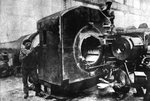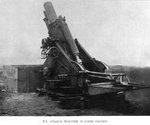CharlesBronson
Senior Master Sergeant
French 400 mm Puteaux monster, this railway howitzer was used to punch holes in the Verdun Fortresses allowing the recapture from accuping german forces. Muzzle Velocity was 510 ms and range 14,5 km.
( edited, video no longer available, see below posts)
( edited, video no longer available, see below posts)
Last edited:




